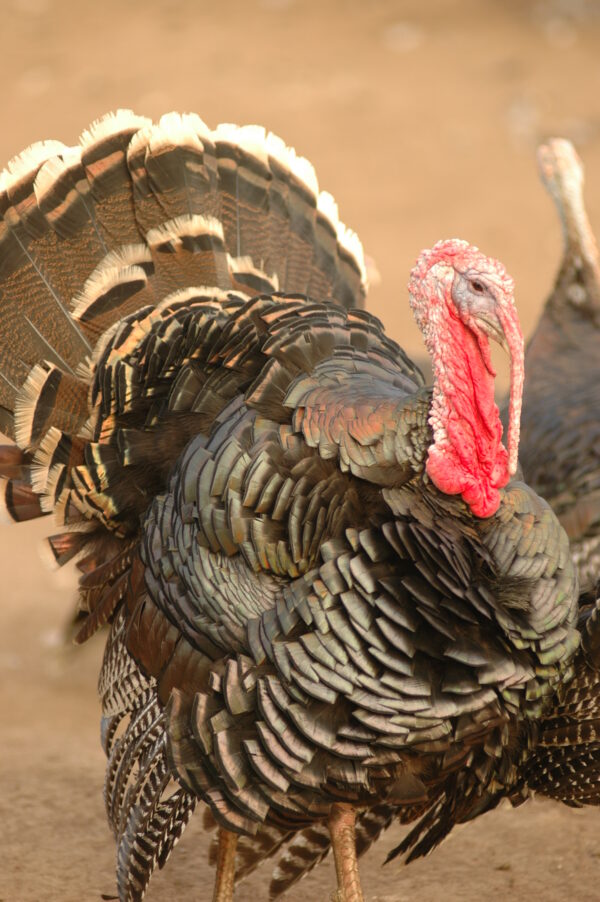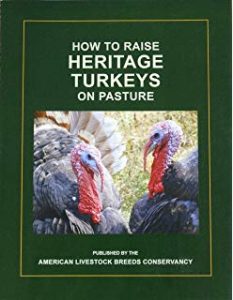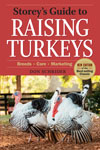 |
Breed Facts
Status:
Watch
Use:
Meat
Egg Color:
Pale cream to medium brown with spotting
Egg Size:
Large
Market Weight:
Male Young – 25 lbs. Mature 35-38 lbs.
Female Young – 16 lbs. Mature 18-22 lbs.
Temperament:
Highly dependent on socialization and selection by breeder; some select for aggressive, others docile
Characteristics:
Too large to fly. Active foragers. Like people.
STANDARD BRONZE TURKEY
The Bronze was the most popular turkey variety for most of American history. Turkeys were originally taken to Europe by Spanish explorers who got them from the indigenous people during their North American exploration in the 1500s. In Europe they became a popular meat bird. These domestic turkeys returned to North America with early colonizers of New England, and were crossed with the Eastern wild turkeys they found upon their arrival. The hybrid vigor of this cross resulted in larger and more vigorous turkeys than the European birds. From those crosses, the modern variety of Bronze turkey was developed. The coppery, bronze-colored metallic sheen, which gives the variety its name, was also part of the inheritance from its wild ancestors.
Bronze-type turkeys were known by the late 1700s, and breeders standardized them throughout the 1800s. Occasional crosses were made back to the wild turkey during these early years. The name “Bronze” was first used in the 1830s for the Point Judith (RI) Bronze, but ultimately was used for all birds of this type. The Bronze variety was recognized by the American Poultry Association Standard of Perfection in 1874.
The status of standard-bred Bronze turkeys changed dramatically during the past century. In the early 1900s, a broader-breasted Bronze turkey was introduced from England into Canada, and then into the northwestern United States. These were crossed with larger, faster-growing US stocks, and the resulting bird, the Broad-Breasted Bronze, became the commercial variety of choice. Further selection improved growth rate, meat production, especially that of breast meat, and other performance qualities. At the same time, changes in conformation, especially the shortening of the legs and the keel, nearly eliminated their ability to mate naturally. For this reason, nearly all Broad Breasted Bronze turkeys are artificially inseminated.
Beginning in the 1960s, the Broad-Breasted White variety replaced the Broad-Breasted Bronze in most commercial production. Retailers favored the white-feathered variety because it produces a cleaner-looking carcass. Today, the Broad-Breasted Bronze is used for niche production, often for large-scale natural or pastured turkey product lines.
Naturally mating, long-lived, slow-growing strains of Bronze turkeys, known as standard-bred Bronze, were left even further behind by the turkey industry. A few tenacious breeders maintained small flocks, participated in poultry shows, and raised a few for family and friends. The Bronze was little used until the early 21st century, when The Livestock Conservancy and its partners launched a successful effort to renew interest in the biological fitness, survivability, and superior flavor of heritage turkeys. This effort captured consumer interest and created a market niche that continues to grow.
The Bronze variety is stately and imposing in appearance. The standard weight for young toms is 25 lbs. and 16 lbs. for young hens. Mature toms can weigh 35-38 lbs. and mature hens 18-22 lbs. Some mature toms can stand up to 4 feet tall and have wing spans of 6 feet! Many of today’s birds remain smaller than the standard, but astute selection can correct this in the flock. Their potential for good growth and size makes Bronze a good choice for raising turkeys for the holiday market, especially for consumers that favor a larger bird for the table.
Their dark brown feathers are tipped with a black band and have a metallic sheen. Males have a deeper sheen and red, purple, green, copper, and gold glints. Wings are glossy bronze; flight feathers are barred white and black. Their tail is black and brown striped, with a wide bronze band, then a narrow black band, and edged with a wide, white band. The coloring of females is more muted, and they may have light lacing on their breasts.
They have rich red wattles that can change to pink or bluish-white, depending on the emotional state of the bird. Their beaks are light at the tip blending to a dark base. They have pinkish shanks and toes as adults, but these are very dark when they are young.
Bronze turkeys can lay about 75 large, cream-to-medium-brown speckled eggs a year. They are good mothers, though many owners choose to incubate the eggs artificially.
They are too large and heavy to fly, but as they are active foragers they like to roam and prefer a lot of space. They are friendly and can be good pets as they may follow their people around like a dog. However, their sociability can be affected by the amount of socialization they get when they are young.
Did you know:
From beginning homesteaders to master breeders, The Livestock Conservancy partners with a vast network of people and breed organizations on the front lines of heritage breed conservation. But you don’t have to raise heritage breeds to support conservation. Join today at Membership & Subscribers – The Livestock Conservancy for as little as $4 monthly.
 |
Breed Facts
Status:
Watch
Use:
Meat
Egg Color:
Pale cream to medium brown with spotting
Egg Size:
Large
Market Weight:
16 -25 lbs
Temperament:
Highly dependent on selection by breeder, Some select for aggressive, others docile
You may be interested in…




